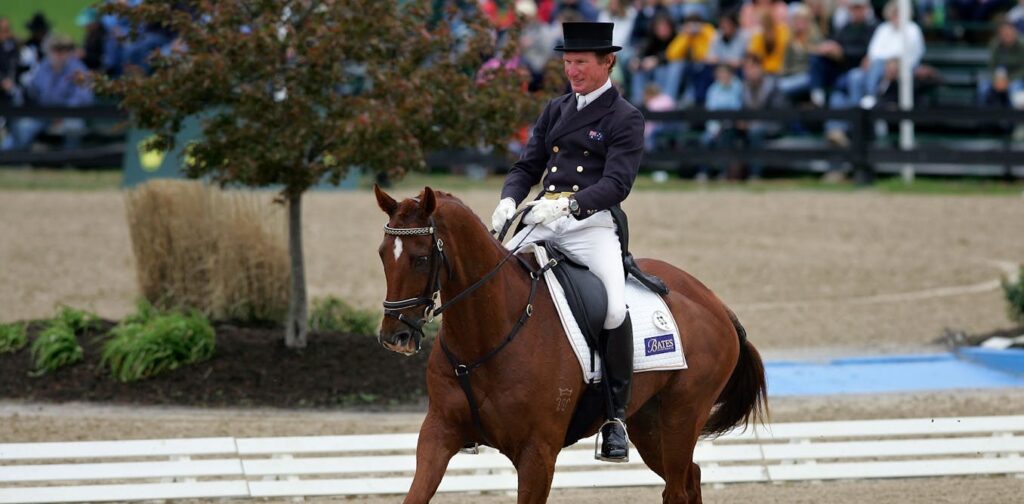
Last week, Equestrian Australia suspended a prominent member following the release of footage allegedly showing Australian Olympic dressage rider Heath Ryan whipping a horse over 40 times. The incident has reignited the debate over the use of whips in equestrian sports, with many calling for a complete ban.
Ryan confirmed he was the rider in the footage, which reportedly dates back two years. He explained that the horse, Nico, belonged to a friend who had been hospitalized due to injuries inflicted by the animal. Ryan described Nico as a “problem child” and claimed that the horse was on the verge of being sent to slaughter before he intervened to “salvage” it.
The Controversial Footage
The footage shows Ryan mounted on Nico, forcefully whipping the horse. The sound of the whip cutting through the air and striking Nico’s flesh is clearly audible. Despite Nico’s visible distress, the whipping continues, leaving the horse appearing “shut down”—a term used to describe a horse that seems to have no understanding of how to stop an adverse experience.
Horses, like humans, have sensitive skin, particularly in the gluteal area where Ryan repeatedly struck Nico. This incident highlights the pain inflicted by whipping and raises questions about its necessity and ethics in equestrian training.
Historical Context and Previous Incidents
This is not the first time that whipping in equestrian sports has come under scrutiny. In July 2024, footage emerged of three-time Olympic dressage gold medallist Charlotte Dujardin repeatedly whipping a horse. The International Equestrian Federation fined her CHF 10,000 (A$18,867) and imposed a 12-month suspension.
More recently, in May 2025, the RSPCA prosecuted trainer Liandra Gray in Australia for striking a horse with a padded racing whip over 40 times. A Tasmanian court found her actions constituted cruelty, causing unreasonable and unjustifiable pain.
Equestrian Australia’s national dressage rules explicitly forbid excessive use of whips, yet incidents continue to occur, prompting calls for stricter enforcement and potential changes to the rules.
Ethical Considerations and Expert Opinions
Despite stating he “hated” whipping Nico, Ryan argued he acted in the horse’s interests by preventing its slaughter. He claims Nico has since been re-homed and is thriving in a competitive environment. However, this raises ethical questions about the justification of such actions.
Ryan’s reasoning is an example of consequentialism, where actions are judged by their outcomes. This perspective raises the question of what constitutes a “good” outcome and who decides the standards for judgment.
Experts argue that this approach reflects a culture that values horses for their utility rather than respecting their needs as sentient beings. Horses are often described as partners in equestrian sports, but the reality is that they have little choice in the matter. Training methods that rely on aversive stimuli, such as whipping, are increasingly viewed as outdated and unethical.
“There is ample scientific evidence showing that unwanted behavior in horses can be modified without resorting to violence,” notes the International Society for Equitation Science (ISES).
Organizations like ISES and the Federation of Veterinarians of Europe highlight the risks of using aversive training methods, which can lead to fear and stress in horses, posing unacceptable welfare risks.
The Path Forward
The incident involving Ryan and Nico has sparked renewed calls for reform in equestrian training methods. Critics argue that it is time to adopt more humane and scientifically-backed approaches to horse training.
ISES has developed a set of 10 principles for training even the most difficult horses, emphasizing the importance of minimizing stress and fear. These principles advocate for positive reinforcement and the removal of aversive stimuli as soon as the horse performs the desired behavior.
While Ryan justified his actions as necessary, the broader equestrian community is increasingly recognizing that such methods are neither necessary nor ethical. The debate continues as to whether a complete ban on whipping in equestrian sports should be implemented to ensure the welfare of horses.
As the equestrian world grapples with these ethical dilemmas, the focus remains on finding a balance between tradition and the evolving understanding of animal welfare.






